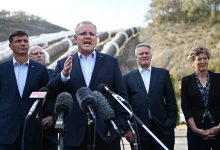New analysis from the Institute for Energy Economics and Financial Analysis (IEEFA) suggests a Morrison government threat to use Snowy Hydro to build a new gas-fired generator would see the government-owned corporation burn through additional taxpayer funds or face being hit with ‘junk’ status from ratings agencies.
Prime minister Scott Morrison has threatened to use Snowy Hydro to build a new gas fired generator in New South Wales if he perceives that there have been insufficient commitments of private sector investment to replace the Liddell Power Station by early 2021.
Morrison initially claimed that 1,000MW of new dispatchable generation capacity would need to be committed by early 2021 to maintain reliable power supplies in NSW, but subsequently walked this back to just 250MW. Government officials recently confirmed to a senate estimates hearing that a reliability gap of just 154MW is expected when Liddell power station closes.
If the Morrison government proceeds with building a new gas plant, a tight balance sheet would likely force Snowy Hydro to raise new funds, as a drop in profits and the costs of the Snowy 2.0 project combine to place significant pressure on its cash balance, which has already necessitated a fresh $1.38 billion injection of taxpayer funds from the federal government.
Snowy Hydro reported a sharp drop in annual profits in October, after a tough year impacted by bushfires that damaged Snowy facilities and a fall in wholesale electricity prices. A proportion of its existing cash reserves are already committed towards the completion of Snowy 2.0, which is expected to cost at least $5.1 billion – a figure that many analysts consider to be a conservative estimate.
In a new briefing paper, IEEFA says that its analysis shows that Snowy Hydro would require a further cash injection of taxpayer funds if it was to undertake the construction of a gas generator or, if forced to raise funds from capital markets, would risk seeing its credit rating further downgraded by ratings agencies to ‘junk’ status and pressures would mount if Snowy 2.0 encountered cost overruns.
“The company has produced its worst ever financial performance,” IEEFA analyst Trista Rose said. “Construction, financing and transmission costs for its flagship Snowy 2.0 project could reach A$10 billion from initial estimates of just $2 billion.”
“It is now unlikely Snowy 2.0 will ever pay a commercial return. Instead, taxpayers are likely to bear the costs of this financially unfeasible project, as well as the environmental burden.”
Snowy Hydro recently saw its credit rating downgraded by S&P, with the ratings agency saying the corporation would already be given a ‘junk’ status if it wasn’t a government-backed corporation. The credit downgrade adds further pressure on Snowy Hydro, as IEFFA argues, it potentially limits the ability of the corporation to raise new funds.
“The eligible pool of investors would be substantially narrowed if future debt raises were required, with many institutional investors unable to hold debt with a credit rating of BB or below. Any future debt raise is also likely to be more expensive to finance and may be out of reach to service as the company already demonstrated in FY20 that it is struggling to meet its interest expense,” the IEEFA briefing paper says.
IEEFA analyst Tim Buckley, a co-author of the briefing paper, added that it was currently a poor time for public funds to be used for investments in the gas industry.
“The gas industry in the first six months of this year alone announced $25 billion dollars in write-offs, which means that gas companies in Australia have lost between 58 and 69% of their value since January 2011,” Buckley said. “Despite the billions already invested into the gas industry over the last few years since Gladstone was developed, the returns that were promised and the tax revenue promised simply have not eventuated.
“Energy Minister Angus Taylor’s technology-neutral approach seems to ignore the ever-larger battery projects being announced both here and globally with increasing frequency, as illustrated by AGL Energy’s newly announced, massive 250MW/1,000MWh battery proposal for South Australia.”
“Subsidising a fossil gas expansion at Snowy Hydro is a very poor bet – creating double the trouble.”









